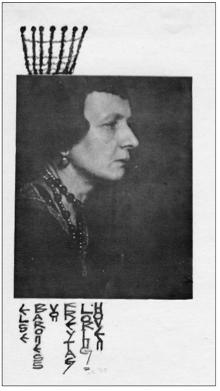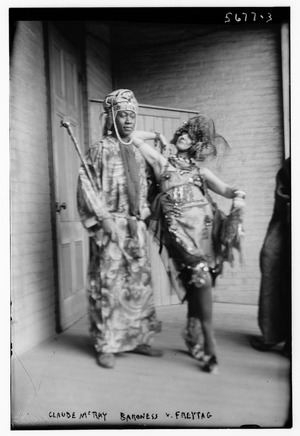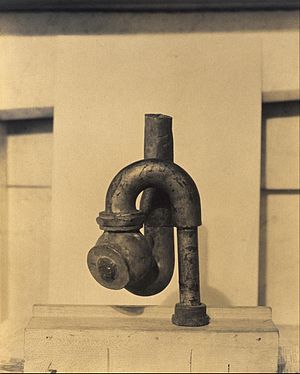Elsa von Freytag-Loringhoven facts for kids
Quick facts for kids
Elsa von Freytag-Loringhoven
|
|
|---|---|

Freytag-Loringhoven portrait, with ink decoration added by the Baroness, as it appeared in the September–December 1920 Issue (Vol. 7, No. 3) of The Little Review (New York).
|
|
| Born |
Else Hildegard Plötz
12 July 1874 Swinemünde, Province of Pomerania, German Empire
|
| Died | 14 December 1927 (aged 53) Paris, France
|
| Known for | Poetry, sound poetry |
|
Notable work
|
Body Sweats |
| Movement | New York Dada, avant-garde |
| Spouse(s) | August Endell Frederick Philip Grove Baron Leopold von Freytag-Loringhoven |
Elsa Baroness von Freytag-Loringhoven (born Else Hildegard Plötz; 12 July 1874 – 14 December 1927) was a German-born avant-garde visual artist and poet. She was very active in Greenwich Village, New York, from 1913 to 1923. Her unique way of expressing herself made her a symbol of Dada art. Many people thought she was one of the most daring and original women artists of her time.
Her bold poems were published after her death in 2011 in a book called Body Sweats: The Uncensored Writings of Elsa von Freytag-Loringhoven. The New York Times newspaper even called it one of the best art books of that year.
Contents
Early Life and Journeys
Elsa Plötz was born on 12 July 1874, in Swinemünde, Germany. Her father, Adolf Plötz, was a mason, and her mother was Ida Marie Kleist. Elsa had a difficult relationship with her father, who she felt was very controlling. This might have made her want to challenge rules and traditions in her art and life. She greatly admired her mother, who was good at making new things from old objects. This skill may have inspired Elsa to use found items in her own art.
Elsa trained and worked as an actress and performer. She also studied art in Dachau, near Munich.
She married Berlin architect August Endell in 1901. Their marriage ended in 1906. In 1907, she married Felix Paul Greve, a poet. In 1910, Elsa joined Greve in the United States, where they lived on a small farm in Kentucky. Greve left her in 1911.
Elsa then moved east, working as a model for artists in cities like Cincinnati and Philadelphia. In November 1913, she married her third husband, the German Baron Leopold von Freytag-Loringhoven, in New York. Around this time, Elsa started making sculptures from objects she found and discarded items. She soon became known as "the dadaist Baroness Elsa von Freytag-Loringhoven."
Her Artistic Work
In New York City, Freytag-Loringhoven earned money by working in a cigarette factory and by posing for artists. She was photographed by famous artists like Man Ray and George Grantham Bain.
Poetry and Writing
The Baroness had her poems published in The Little Review magazine starting in 1918. Her work appeared alongside parts of James Joyce's famous novel Ulysses. Jane Heap, one of the magazine's editors, called the Baroness "the first American dada." Most of her poems were not published until the book Body Sweats came out. Her friend and fellow artist Djuna Barnes saved her personal writings after her death.
Art from Found Objects and Performances
In New York, the Baroness also created assemblages, sculptures, and paintings. She made art from trash and items she found on the streets. She was famous for making amazing costumes from these found objects. People said she created a "living collage" because her art and her life were so closely connected.
The Baroness's unique costumes challenged common ideas about beauty and value. She would decorate herself with everyday items like spoons, tin cans, and curtain rings, as well as street debris. By using her own body as art, she wanted to create a special kind of show. She aimed to challenge what society expected women to be like. Her body art was not just a sculpture or a living collage, but also a form of Dada performance art.
Not many of the Baroness's artworks still exist today. Some known works made from found objects include Enduring Ornament (1913), Earring-Object (1917–1919), Cathedral (around 1918), and Limbswish (around 1920). Her Portrait of Marcel Duchamp (1920–1922) was found by the Whitney Museum in New York City in 1996.
There is also a discussion about whether some artworks, usually given to other artists, might have been partly created by the Baroness. For example, a work called God (1917) was for many years thought to be only by Morton Livingston Schamberg. Now, the Philadelphia Museum of Art says the Baroness was a co-creator of this piece. Some believe she came up with the idea and title for the artwork.
The Fountain Sculpture (1917)
One of the most famous modern art sculptures made from plumbing is Fountain (1917), by Marcel Duchamp. Recently, some people have suggested that the Baroness might have been involved in its creation. This idea comes from a letter Duchamp wrote to his sister Suzanne in 1917. In the letter, he mentioned that "One of my female friends under a masculine pseudonym, Richard Mutt, sent in a porcelain urinal as a sculpture."
Some historians believe the "female friend" Duchamp mentioned was the Baroness. Duchamp never said who this friend was. It's important to remember that Duchamp wrote "sent" and not "made." This means he was not saying someone else created the artwork, but that someone else submitted it.
Later Life and Legacy
In 1923, Freytag-Loringhoven returned to Berlin, hoping to find better opportunities. However, Germany was struggling after World War I, and she faced economic hardship. She remained in Germany, often without money. Friends from the expatriate community, like Bryher, Djuna Barnes, Berenice Abbott, and Peggy Guggenheim, helped her emotionally and financially.
Her mental health improved when she moved to Paris. She died on 14 December 1927, from gas suffocation. She is buried in Père Lachaise Cemetery in Paris.
In 1943, the Baroness's work was shown in Peggy Guggenheim's exhibition Exhibition by 31 Women at the Art of This Century gallery in New York.
Books About Her Life
The Baroness was known as one of the "characters, one of the terrors of the district," according to her first biographer, Djuna Barnes. Barnes's book was never finished.
Another book, Irrational Modernism: A Neurasthenic History of New York Dada, by Amelia Jones, looks at the history of New York Dada through the Baroness's life and art.
In 2002, a biography called Baroness Elsa: Gender, Dada and Everyday Modernity, by Irene Gammel, argued for the Baroness's artistic talent and bold spirit. This book explores her relationships with artists like Djuna Barnes, Berenice Abbott, Jane Heap, Duchamp, Man Ray, and William Carlos Williams.
In 2013, artists Lily Benson and Cassandra Guan released The Filmballad of Mamadada. This was an experimental movie about the Baroness's life, created with help from over 50 artists and filmmakers.
See also
 In Spanish: Elsa von Freytag-Loringhoven para niños
In Spanish: Elsa von Freytag-Loringhoven para niños
- List of German women artists
- Portrait of Marcel Duchamp



